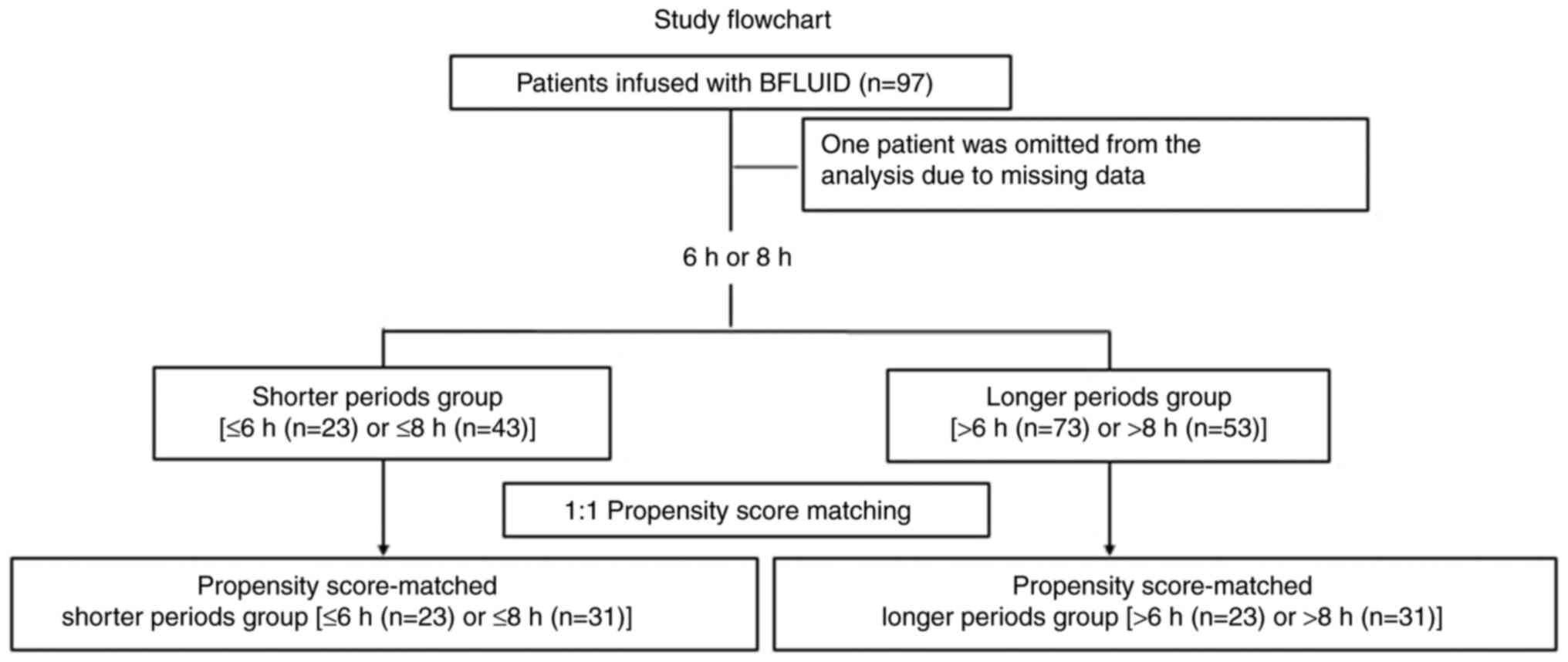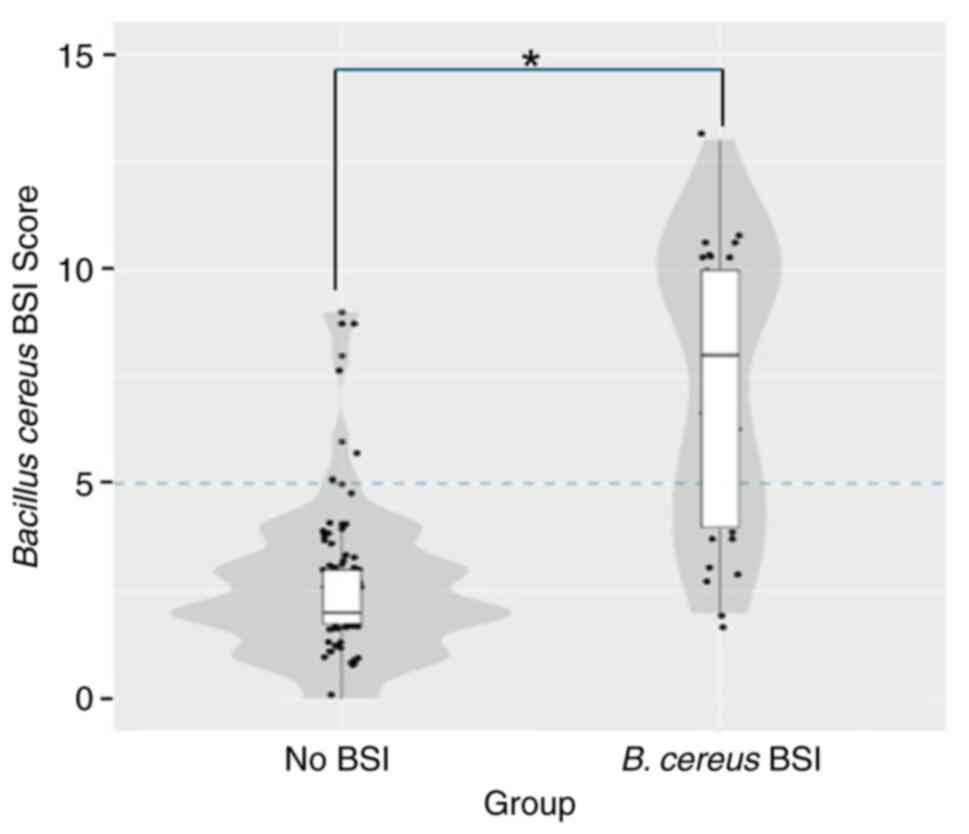|
1
|
Bottone EJ: Bacillus cereus, a volatile
human pathogen. Clin Microbiol Rev. 23:382–398. 2010.PubMed/NCBI View Article : Google Scholar
|
|
2
|
Pearson HE: Human infections caused by
organisms of the Bacillus species. Am J Clin Pathol. 53:506–515.
1970.PubMed/NCBI View Article : Google Scholar
|
|
3
|
Japan Nosocomial Infections Surveillance
in 2022: Ministry of Health, Labour and Welfare, 2023. https://janis.mhlw.go.jp/report/open_report/2022/3/1/ken_Open_Report_202200.pdf.
|
|
4
|
Kusama Y, Honma I, Masuda M, Goto H and
Onodera S: Bacillus cereus outbreak in normal neonates at our
hospital. Kankyo kansen-shi [Environmental Infection Magazine].
30:385–390. 2015.
|
|
5
|
Matsumoto S, Suenaga H, Naito K, Sawazaki
M, Hiramatsu T and Agata N: Management of suspected nosocomial
infection: an audit of 19 hospitalized patients with septicemia
caused by Bacillus species. Jpn J Infect Dis. 53:196–202.
2000.PubMed/NCBI
|
|
6
|
Aso Y, Nagatomi M, Nakazawa T, Sasaki S
and Ishi K: Examination of infusion fluid type and environmental
factors involved in increased Bacillus cereus bloodstream
infection. Jpn J Environ Infect. 27:81–90. 2012.
|
|
7
|
Nakamura K, Yarimizu A, Ihara T, Sawayama
Y and Ishimaru T: An analysis of a case in which Bacillus cereus
bacteremia developed from the use of carry-on towels which resulted
in the horizontal transmission of this organism in the same ward.
Kansenshogaku zasshi. 92:80–85. 2018.(In Japanese).
|
|
8
|
Hino C, Ozaki M, Kitahara T, Kouda K,
Shikichi K, Nakamura I, Kawai S and Oie S: Peripheral parenteral
nutrition solutions and bed bath towels as risk factors for
nosocomial peripheral venous catheter-related bloodstream infection
by bacillus cereus. Int J Med Sci. 20:566–571. 2023.PubMed/NCBI View Article : Google Scholar
|
|
9
|
Kutsuna S, Hayakawa K, Kita K, Katanami Y,
Imakita N, Kasahara K, Seto M, Akazawa K, Shimizu M, Kano T, et al:
Risk factors of catheter-related bloodstream infection caused by
Bacillus cereus: Case-control study in 8 teaching hospitals in
Japan. Am J Infect Control. 45:1281–1283. 2017.PubMed/NCBI View Article : Google Scholar
|
|
10
|
Sakihama T and Tokuda Y: Use of peripheral
parenteral nutrition solutions as a risk factor for Bacillus cereus
peripheral venous catheter-associated bloodstream infection at a
Japanese tertiary care hospital: A case-control study. Jpn J Infect
Dis. 69:531–533. 2016.PubMed/NCBI View Article : Google Scholar
|
|
11
|
Kuwahara T, Kaneda S, Shimono K and Inoue
Y: Effects of lipid emulsion and multivitamins on the growth of
microorganisms in peripheral parenteral nutrition solutions. Int J
Med Sci. 10:1079–1084. 2013.PubMed/NCBI View Article : Google Scholar
|
|
12
|
Sasahara T, Hayashi S, Hosoda K, Inagawa
H, Morisawa Y and Hirai Y: Bacterial growth in intravenous fluid
products. In: Proceedings in the 11th East Asian Conference on
Infection Control and Prevention (EACIC) [abstract], Tokyo, Japan.
EACIC, p24 2012.
|
|
13
|
Kuroki R, Kawakami K, Qin L, Kaji C,
Watanabe K, Kimura Y, Ishiguro C, Tanimura S, Tsuchiya Y, Hamaguchi
I, et al: Nosocomial bacteremia caused by biofilm-forming Bacillus
cereus and Bacillus thuringiensis. Intern Med. 48:791–796.
2009.PubMed/NCBI View Article : Google Scholar
|
|
14
|
Shiota A, Asai N, Koizumi Y, Watanabe H,
Sakata M, Kurumiya A, Takahashi T, Muramatsu Y, Hagihara M,
Suematsu H, et al: Extended drip infusion of peripheral parental
nutrition containing amino acids might be associated with Bacillus
cereus bloodstream infection. Am J Infect Control. 47:1154–1156.
2019.PubMed/NCBI View Article : Google Scholar
|
|
15
|
Sakai Y, Konishi T, Obayashi Y, Honda K,
Akae S and Ishihara K: Study of growth level of Bacillus cereus in
various infusion fluids. Shimane J Med Technol. 40:19–23. 2012.
|
|
16
|
Bonnett LJ, Snell KIE, Collins GS and
Riley RD: Guide to presenting clinical prediction models for use in
clinical settings. BMJ. 365(l737)2019.PubMed/NCBI View
Article : Google Scholar
|
|
17
|
Shimoda M, Tanaka Y, Morimoto K, Yoshimori
K and Ohta K: Risk factors for bloodstream infection in patients
receiving peripheral parenteral nutrition. Intern Med 2024 (Epub
ahead of print).
|
|
18
|
Minatoguchi S, Nomura A, Imaizumi T,
Sasaki S, Ozeki T, Uchida D, Kawarazaki H, Sasai F, Tomita K,
Shimizu H and Fujita Y: Low serum albumin as a risk factor for
infection-related in-hospital death among hemodialysis patients
hospitalized on suspicion of infectious disease: A Japanese
multicenter retrospective cohort study. Ren Replace Ther.
4(30)2018.
|
|
19
|
Payne-James JJ and Khawaja HT: First
choice for total parenteral nutrition: The peripheral route. JPEN J
Parenter Enteral Nutr. 17:468–478. 1993.PubMed/NCBI View Article : Google Scholar
|












